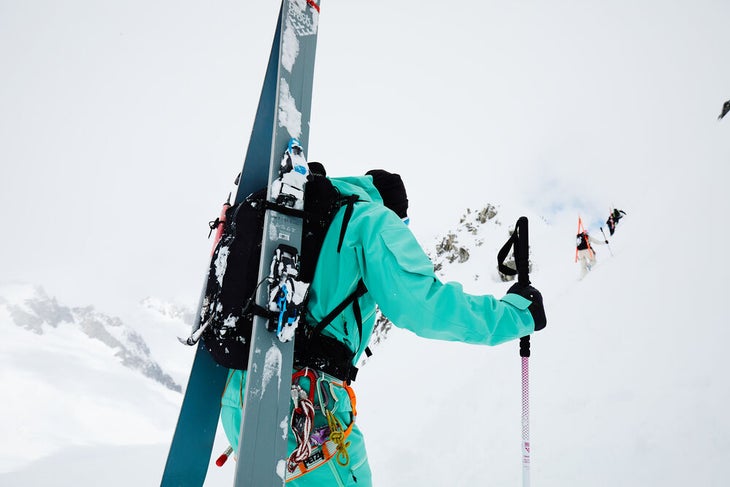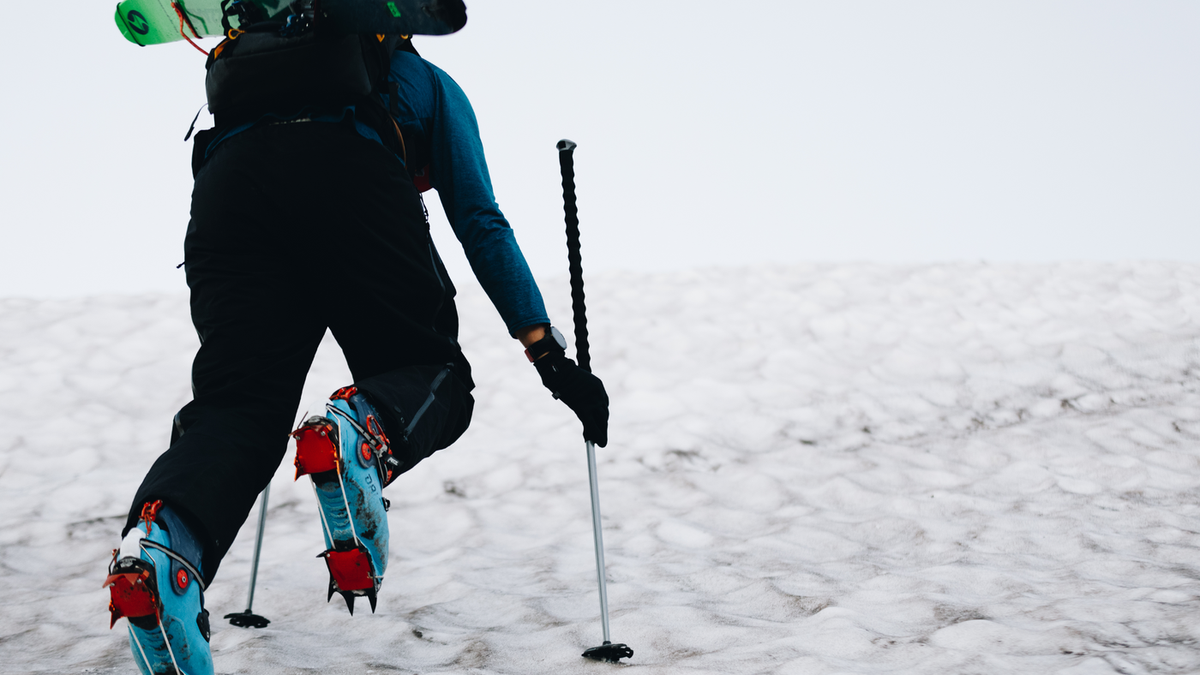Products You May Like
For decades, ski poles have been a pretty boring piece of gear on the backcountry checklist. Essential? Definitely. A hot ticket gear item? Absolutely not. Until now.
Colorful, extended grip poles are the biggest trend in backcountry skiing at the moment, edging out the telescoping poles that have been standard for so long. For many North American skiers, their first sighting of these goofy looking poles was across the pond. Les Batons d’Alain originated on the steep slopes surrounding the Chamonix Valley, created by mountain guide Alain Desez, as a stronger and simpler alternative to traditional extendable poles.
The design is no-frills: an aluminum shaft, wrapped about two thirds of the way down with ribbed foam so the skier can choke up on the pole as needed while skiing in steep terrain, sidehilling, or bootpacking.
 Les Batons d’Alain is currently the biggest name in fixed-length, long-grip ski poles. (Photo: Courtesy of Les Batons)
Les Batons d’Alain is currently the biggest name in fixed-length, long-grip ski poles. (Photo: Courtesy of Les Batons)
Intrigued by the unique pole design he saw in the Alps but unable to find anything similar stateside, AJ Rehn founded Folkrm in November 2021, becoming the first U.S. brand to manufacture a long grip, fixed length backcountry pole (currently, Skimo Co is the only U.S. retailer to sell Batons). Based out of Hood River, Ore., Rehn and his partner Brodie Sutherland built the Wyeast Pole, an aluminum shaft with an extended EVA grip and a molded, rubberized top cap that makes it easy to flick heel risers up and down.
Related: 14 touring essentials for the skintrack enthusiast and backcountry adventurer
“The quickest adoption has been in the guide and ski patrol community who need solid, reliable gear that’s simple and makes sense,” says Rehn of their roster made up of IFMGA guides, professional ski mountaineers, avalanche instructors, and patrollers.
Steep skiers tout the superiority of these poles, but you don’t have to be hop-turning down 50-degree slopes to appreciate the simplicity they offer. Choking up on the extended grip while sidehilling and bootpacking feels intuitive, and the EVA insulation (or foam on the Batons) makes it comfortable to grip your sticks without gloves on warm spring tours. The stiff design is also ideal for digging out a quick hand pit along the skintrack and the rigidity feels strong and supportive when pivoting around your poles on the descent.

Pete Stone, a ski and rock guide in the Tetons, has been skiing with Batons for the past four years and says that durability is a huge factor. “I’ve broken several pairs of those carbon, extendable poles. More moving pieces just means more chance for something to break.”
Related: Backcountry skills you didn’t learn in your Avy 1 course (but need to know)
Stone also says that he notices an uptick in ski performance, both for himself and with skiers he guides, because of how easy it is to adjust hand position. “Watching clients start to use them, I’ve seen their skiing improve because their pole plant is better. Instead of swinging around these super long poles, you can adjust your grip to match the steepness of the slope. If a pole can improve your ski performance that’s a pretty huge upgrade.”
Stone mentions other subtle advantage of the long-grip poles, adding that the simple design is easier to plunge upside down into the snow to secure yourself while climbing soft, steep snow.
Folkrm poles are a little sleeker and more subdued, while Batons have really leaned into the bright, crazy European vibe with camo colorways as well as French and Italian flags. A few others, like the Black Crows Oxus Poles and Scott RC Pro have adopted the fixed-length design, but with a slightly more subtle approach to the extended grip. And although they were both designed with backcountry skiing in mind, plenty have found the extended-grip poles to offer benefits inbounds, too. “Poles take so much more abuse in the resort since you’re putting so much more force through them,” says Rehn. “Plus, when you tuck them under your leg on the lift the insulated EVA doesn’t make your leg cold.”
So, are these goofy poles here to stay? With sales skyrocketing, it’s hard to imagine this trend slowing down. “I’ve heard some folks in the industry who aren’t that psyched about it because they say it looks dumb,” says Stone. “But I think everyone’s going to be using them in the next 5 years. Everything looks dumb until everyone is doing it.”
